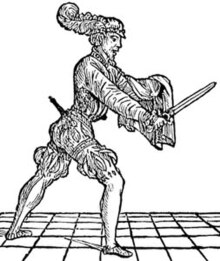Cloak and dagger

"Cloak and dagger"was a fighting style common in the Renaissance involving a knife hidden beneath a cloak. The term later came into use as a metaphor, referring to situations involving intrigue,secrecy,espionage,or mystery.
Overview
[edit]In "The Knight's Tale",published around 1400, English poetGeoffrey Chaucerreferred to "The smiler with the knife under the cloak".[1]
Taken literally, the phrase could refer to using the cloak and dagger inhistorical European martial arts.The purpose of the cloak was to obscure the presence or movement of the dagger, to provide minor protection from slashes, to restrict the movement of the opponent's weapon, and to provide a distraction. Fencing masterAchille Marozzotaught and wrote about this method of combat in his book,Opera Nova.Fighting this way was not necessarily seen as a first choice of weapons, but may have become a necessity in situations of self-defense if one were not carrying a sword, with the cloak being a common garment of the times that could be pressed into use as a defensive aid. Both Marozzo and other masters such asDi Grassialso taught the use of the cloak with the rapier.[2][3]
The metaphorical meaning of the phrase dates from the early 19th century. It is a translation from theFrenchde cape et d'épéeandSpanishde capa y espada( "of cloak and sword" ). These phrases referred to a genre ofswashbucklerdramain which the main characters wore these items. In 1840,Henry Wadsworth Longfellowwrote, "In the afternoon readLa Dama DuendeofCalderón– a very good comedy of 'cloak and sword'. "Charles Dickenssubsequently used the phrase "cloak and dagger" in his workBarnaby Rudgea year later as a sarcastic reference to this style of drama.[4]The imagery of these two items became associated with the archetypal spy orassassin:thecloak,worn to hide one's identity or remain hidden from view, and thedagger,a concealable and silent weapon.[citation needed]
In contemporary culture
[edit]The sword fight inPeter Martins' ballet ofRomeo + Julietculminates in Romeo stabbing Tybalt repeatedly in the back with a dagger, having flung his cloak over the latter's head.
Cloak and Daggerare also the names of twoMarvel Comicscharacters debuting in 1982.
The Spy inTeam Fortress 2owns a wristwatch called "The Cloak and Dagger", alluding to his affinity towards knives and backstabbing.
SEAL Team ONE's unit logo features a seal wrapped in a cloak, holding a dagger, referencing the nature of their clandestine missions.
References
[edit]- ^Geoffrey Chaucer, "The Knight's Tale" inCanterbury Talesc 1400.
- ^DiGrassi, His True Arte of DefenceThe entire Di Grassi manual translated into English.
- ^UNC.eduA version of "The Rapier and Cloake" that is easier to read and includes an illustration.
- ^Dickens, Charles (1841).Barnaby Rudge: A Tale of the Riots of 'Eighty.London: Chapman & Hall. p. 203.ISBN0-14-043728-2.
...his servant brought in a very small scrap of dirty paper, tightly sealed in two places, on the inside whereof was inscribed in pretty large text these words:A friend. Desiring of a conference. Immediate. Private. Burn it when you've read it."Where in the name of the Gunpowder Plot did you pick up this?" said his master. "It was given him by a person then waiting at the door", the man replied. "With a cloak and dagger?" said Mr Chester.
